GIS-Based Public Services Analysis Based on Municipal Election Areas: A Methodological Approach for the City of Makkah, Saudi Arabia
Gomaa M. Dawod, Meraj N. Mirza, Ramze A. Elzahrany, Khalid A. Al-Ghamdi
Deaprtment of Geography, Umm Al-Qura University, Makkah, Saudi Arabia
Email: gmmahmoud@uqu.edu.sa
Journal of Geographic Information System, Vol.5, No.4, (2013),373 - 395:
ABSTRACT
The spatial fairness of public services is a major aspect in offering a healthy and cheerful living environment in a city. The Geographic Information System (GIS) technology has been applied to investigate the spatial distribution of some selected public services over the municipal election areas within Makkah city, Saudi Arabia. These services include education, health, security, religious, commercial, and sports services. The attained results show that except for religious services, other public services are not quantitatively proportional with the population variations in Makkah. It has been found that the third election area posses almost one third of five public services and two thirds of the sport services. That might be attributed to the fact that the third election area possesses almost a one quarter of the city population. But, although the first election area has a closer percentage of the total population, it does not include a comparable percentage of public services. On a spatial basis, results of GIS spatial analysis (particularly the Euclidian distance, the mean distance band to a neighbor, the standard distance, the directional distribution ellipse, and the average nearest neighbor ratio tools) have concluded that there is inequity in the services distribution over municipal election areas in Makkah city. Consequently, it is recommended that local planners and decision makers should take the obtained results into consideration to achieve fair and better distribution of public services in the city.
1. Introduction
Public services and facilities are essential for residents in any city all over the world in general, and in developing countries in particular. Governments start to rethink the delivery of public services in order to enhance their quality and quantity, to meet public’s needs and expectations [1]. Improving efficiency of basic public services for residents has been recognized as one of the major ways of promoting sound human settlements, good health, and appropriate and decent living conditions. Assessing efficiency of public services is multidimensional and includes several factors such as geographic and financial accessibility, availability, quantity, distribution, quality, and clients’ satisfaction. However, spatial distribution is of great importance. Thus, spatial analysis of public services distribution gains an increasing attention in the last decades from both geographic and environmental perspectives [2]. Moreover, the issue of spatial equity of urban public facilities has proliferated recently from both planning and geographic points of view, trying to arrive to the so-called spatial justice [3]. Diagnosing the current situation of a public service is quite essential in planning its new spatial locations in order to increase the service availability and accessibility to residents [4]. Geographic Information System (GIS) plays an important technical role in spatial analysis of geographic features. GIS has been utilized in a wide range of mapping and analysis applications all over the world in general, and in Kingdom of Saudi Arabia (KSA) in particular. Such GIS applications include, for instance, urban growth monitoring [5], flood management [6], and health services’ spatial analysis [7]. Concerning services spatial analysis, GIS has been applied in several studies. For example, Zhou et al. [8] have utilized GIS to identify and map the distribution pattern of public and community facilities in a study area in four neighboring sub-districts in Beijing, China and to analyze their spatial equity. Moreover, Mavo et al. [9] investigated the utilization of GIS to assess accessibility of public transit in New Zealand. Similarly, GIS was used to develop a site suitability model for social services in Atlanta city [10]. In addition, GIS has been applied to identify spatio-temporal gaps in public transportation services in Belgium [11]. In Saudi Arabia, public services are mainly provided by the government with significant attention to the holy city of Makkah. During the period 1990 to 2010, Makkah total residential area had been increased from 99.23 to 158.58 square kilometers, with 4.8% annual rate [5]. In addition, the annual population growth rate in KSA is almost 2.9%. Both growing rates emphasize the need for new public services in terms of quantities and spatial distribution. This paper utilizes GIS for mapping and analyzing the distribution of existing public services based on municipal election areas in Makkah.
2. The Study Area
Makkah city is located in the western region of the Kingdom of Saudi Arabia (KSA), about 80 km east of the Red Sea (Figure 1). It extends from longitudes 39˚35'E to 40˚02'E, and from latitudes 21˚09'N to 21˚37'N. Makkah city is a sacred city for all Muslims; since it houses Al-Masjid Al-Haram (the Holy Mosque). All Muslim are expected to perform Hajj “pilgrimage” to Makkah once in their life time if they can afford it. Thus, million Muslims gather in Makkah yearly. Also, Muslims perform Omrah “a religious visit to Makkah” all over the years. The religious functionality of Makkah is an important factor to be considered when analyzing its services distribution. For instance, there are several seasonal allocations of public services, e.g. health and security services, in the holy sites. The seasonal services have been excluded in the current research. Moreover, the topography of Makkah is complex, and several mountainous areas exist inside its metropolitan area. That is a vital element in investigating the spatial pattern of Makkah sprawl and service spatial locations. Terrain elevations in Makkah (Figure 2) range from 82 to 982 meters above sea level [12]. Al-Ghamdi et al. [5] have concluded that the urban growth in Makkah city (between 1947 and 2010) take a radial (or spoke) pattern. That is logically understood knowing that the holy mosque is considered the center of the city, and the central area around it has the highest population density since residents and pilgrims prefer to stay close to this holy mosque.
Makkah city is composed of 60 districts, one of them is a special area containing the holy sites of Mina, Muzdalifa, and Arafat. This last district is excluded from the

Figure 1. Study area.
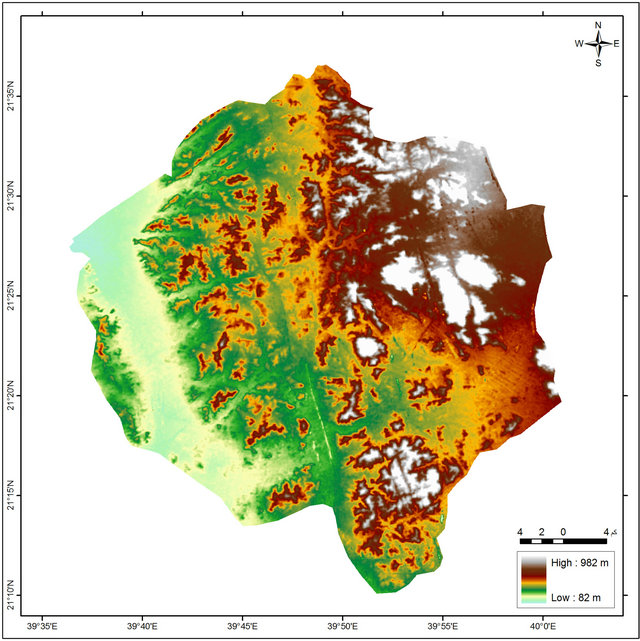
Figure 2. Topography of Makkah city.
current study, since its public services are seasonal in nature and operate only during the pilgrimage seasons. There are seven municipal election areas in Makkah, where the seventh area contains the western villages outside the urban extents of the city. Hence, only the six urban municipal election areas within the city have been considered in this study (Figure 3). Table 1 andFigure 4 present the population relative distribution over the municipal election areas of Makkah city. It can be seen the third election area posses the highest population percentage, and it contains more than a quarter of the city total population. The first election area, which is the central area of the city, ranks second. The fifth and sixth municipal election areas contain the least population portions, since they are newly urbanized areas.
3. Available Data
The quantity and spatial distribution of six types of public services have been investigated in this study. They include: general education services, security services, health services, commercial services, religious services, and sport services. The corresponding GIS shapefiles have been obtained from the Holy City Municipality’s base map released in 2012. However, these shapefiles depict both existing and planned services. In order to limit the current study to the existing services only, sev-

Table 1. Distribution of population percentage on municipal election areas.
eral editing process using ArcGIS 10.0 have been carried out to eliminate non-existing features on recent IKONOS satellite imageries of Makkah city. Education services have been grouped into four sub-types; kindergarten, primary schools, intermediate schools, and secondary or high schools (Figure 5). Also, security services have been divided into fire stations, police stations, and traffic facilities (Figure 6). Health services include both governmental and private facilities (Figure 7). Three subtypes of religious services have been assessed (Figure 8). Similarly, commercial services, markets in particular, have been divided into three sub-groups (Figure 9), and sports services have been divided into three sub-types too (Figure 10).
4. Methodology and Data Processing
The analysis of public services distribution has been car-

Figure 3. Districts and municipal election areas.
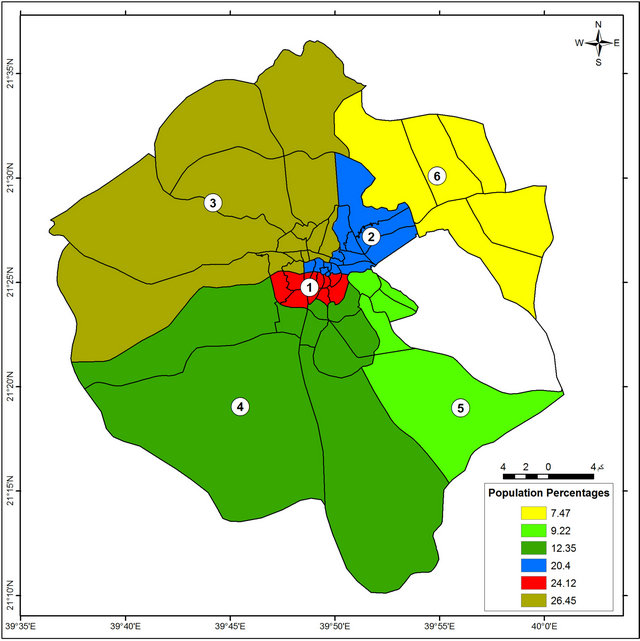
Figure 4. Population relative distribution.
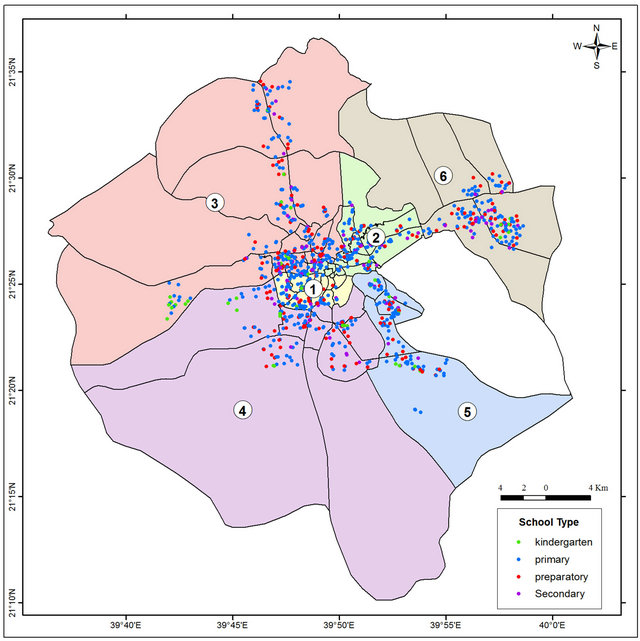
Figure 5. Education services.
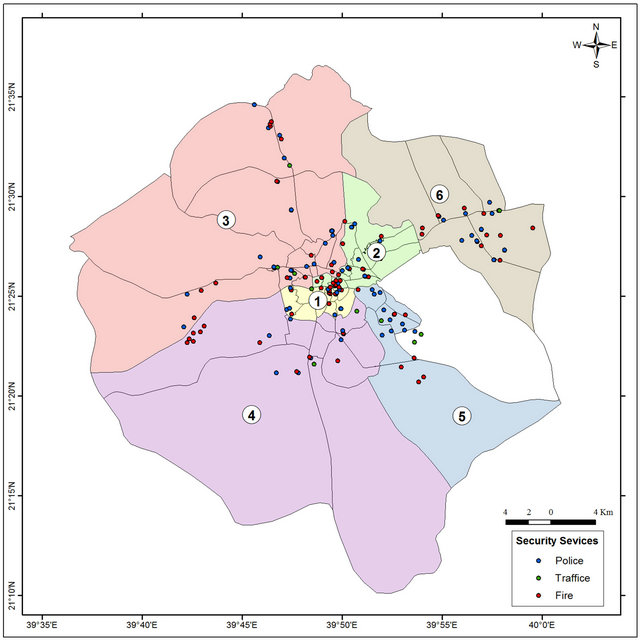
Figure 6. Security services.
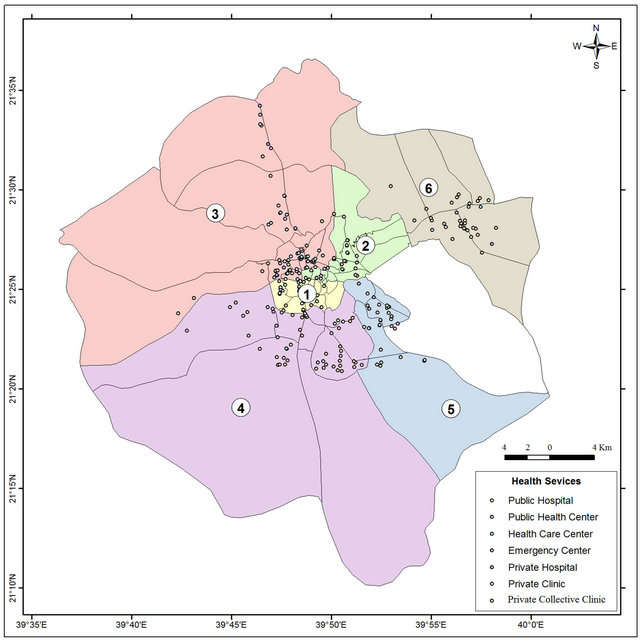
Figure 7. Health services.
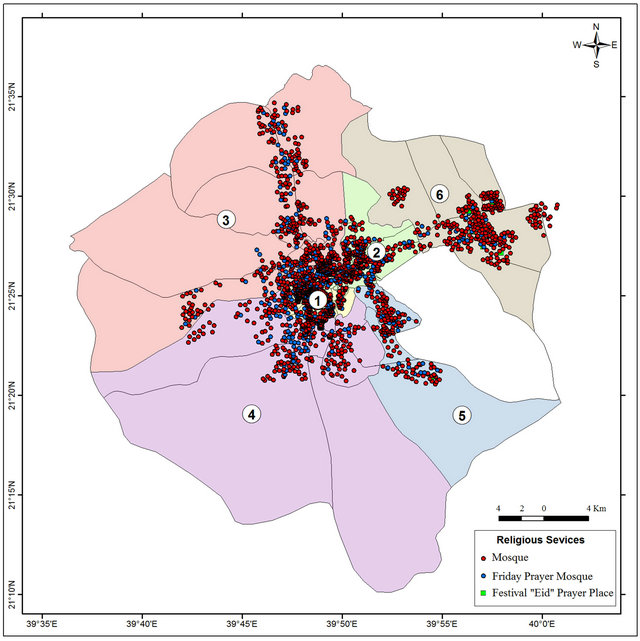
Figure 8. Religious services.

Figure 9. Commercial services.
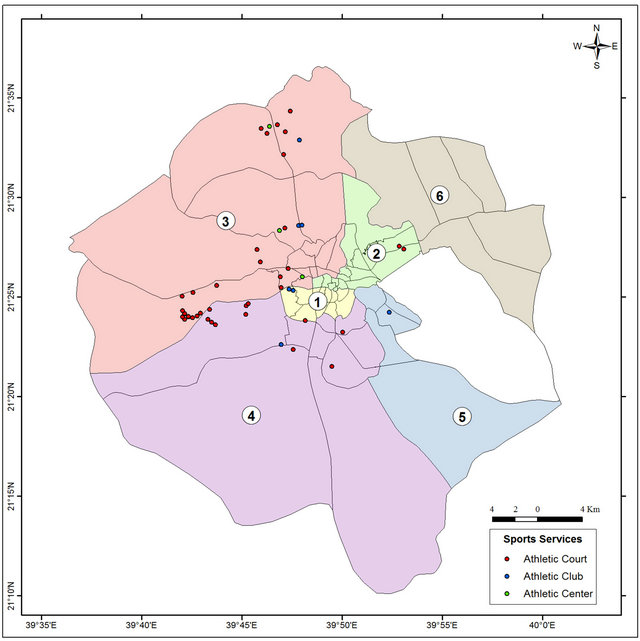
Figure 10. Sports services.
ried out on both statistical and spatial scales within the municipal election areas of Makkah. First, ArcGIS has been used to split each service’s spatial distribution over the municipal election areas. Thus, the quantity of each sub-type of the utilized public services has been obtained. So, a percentage portion has been computed for each sub-category of a specific service for each election area. For more simplicity, these percentage figures have been scaled by 10 in order to obtain a simple measure on a scale ranges from 1 to 10. Let us denote such a scale Ri, j, where i denotes a public service, and j denotes sub-types within that service. So, i in our study ranges from 1 to 6 (number of available public services types), and j varies from 1 to 7 according to numbers of sub-categories in each public service. Another factor, Ti, has been computed that represents, on a scale from 1 to 10, the relative portion of each public service located within each election area. That means that Ti accounts generally for a specific service, while Ri, j accounts for sub-types within each service. Next, an overall indicator has been computed to describe the availability and relative distribution of public services over the municipal election areas in Makkah city. This indicator is called Public Services Index (PSI) as:
 (1)
(1)
where m equals the total numbers of public services’ sub-types (that is 24 in the current study). PSI, also, has a value ranges from 0 to 10 for simplicity, and the sum of PSI's indices equals 10 for a certain public service. Thus, it can be though of as a measure of justifiable distribution of public services over municipal election areas in Makkah city.
In the next processing stage, the equity issue of public services distribution, with respect to population variations, has been investigated. In this regard, the Lorenz curve and the Gini index have been utilized. The Gini index or coefficient is based on the Lorenz curve, a cumulative frequency curve that compares the distribution of a specific variable with the uniform distribution that represents equality. This equality distribution is represented by a diagonal line, and the greater the deviations of the Lorenz curve from this line, the greater the inequality. By putting commutative proportion of a particular public service in the y axis and commutative proportion of population of the election area in the x axis, the area of equality is being calculated. A low Gini coefficient indicates a more equal distribution, with 0 corresponding to complete equality. While higher Gini coefficients indicate more unequal distributions, with 1 corresponding to complete inequality. In addition, correlation and geographically weighted regression analysis have been performed to investigate the statistical characteristics between the public services quantity and distribution and the population variations in the municipal election areas. Then, a prediction has been attained to estimate the required public services in Makkah city in 2020. The spatial analysis stage includes the utilization of selected four main spatial tools available in ArcGIS. The Euclidian distance, the standard distance, the directional distribution ellipse, and the average nearest neighbor ratio. The Euclidian distance tool calculates for each cell or feature the zone of the closest source location in Euclidean distance. Hence, the attained raster represents the spatial variation of a specific public service over the municipal election areas of Makkah city. The standard distance and the directional distribution ellipse are spatial analysis tools measure the geographic distribution. On the other hand, the directional distribution tool measures whether a distribution of features exhibits a directional trend, i.e. whether features are farther from a specified point in one direction than in another direction.
5. Results and Discussion
Starting with the statistical analysis, Table 2 and Figure 11 present the index of relative portion of each public

Table 2. Relative distribution of public services (on a scale 0 to 10).
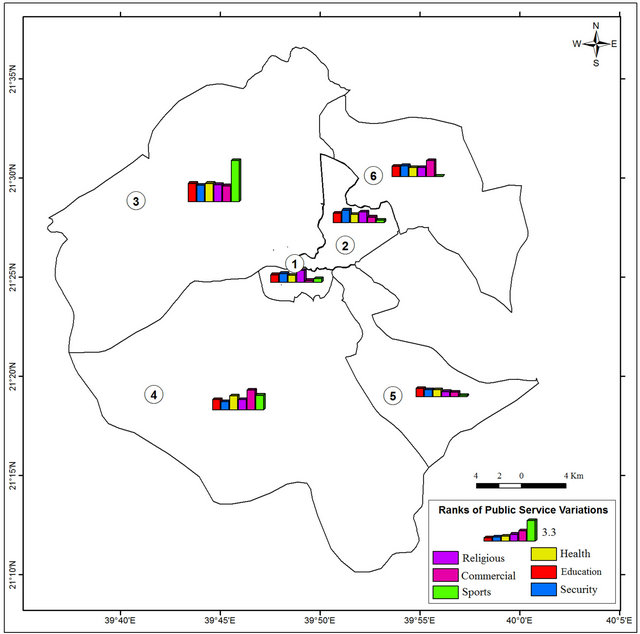
Figure 11. Public services variations.
services over the municipal election area (on a scale 0 - 10). From this table, it can be noticed that the third election area posses almost one third of five public services and two thirds of the sport services. This election area comes in the first rank in all public services distribution except commercial services, where the forth municipal election area becomes first. This result might be attributed to the fact that the third election area possess almost a one quarter of the city population (Table 1). But, although the first election area has a close percentage of the total population, it does not include a comparable percentage of the public services. So, and as a general remark, it can be concluded that there is inequity in the services distribution over municipal election areas in Makkah city. The overall indicator (PSI is Equation (1)) is shown in the last column of Table 2, and depicted in Figure 12. PSI describes the availability and relative distribution of public services over the municipal election areas in Makkah city. It can be concluded that the third election area is the first-ranked area regarding public services availability and quantity. On the other hand, both first and fifth municipal election area comes in the last, or least, rank in this regard. Again, the values of PSI index prove the unfairness nature of public service distribution in Makkah city.
Next, the Lorenz curves and the Gini indices have been developed. Figure 13 and Table 3 present the at-
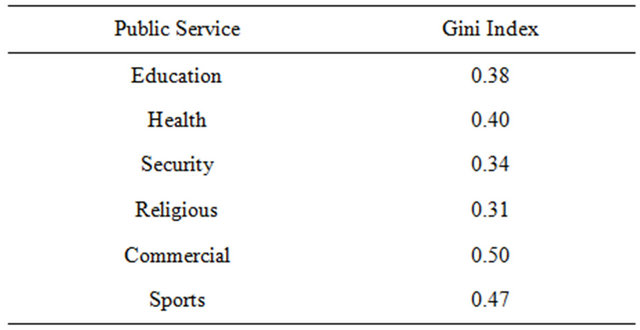
Table 3. Gini index of public services.
tained results. It can be seen from these table and figure that the inequality of service distribution is significant for both the commercial and sports services. On the other hand, the religious and security services seem to have a reasonable fairness in distribution over the municipal election areas. Both health and education services have a medium equality in their distribution over the city municipal election areas.
Similar conclusions can be drawn from the correlation factors between public services and population of the municipal election areas (Table 4). It can be seen that the religious services show a strong positive correlation with population of municipal election areas, while the unequal distribution of the commercial services produces a weak negative correlation. That might be attributed to the fact
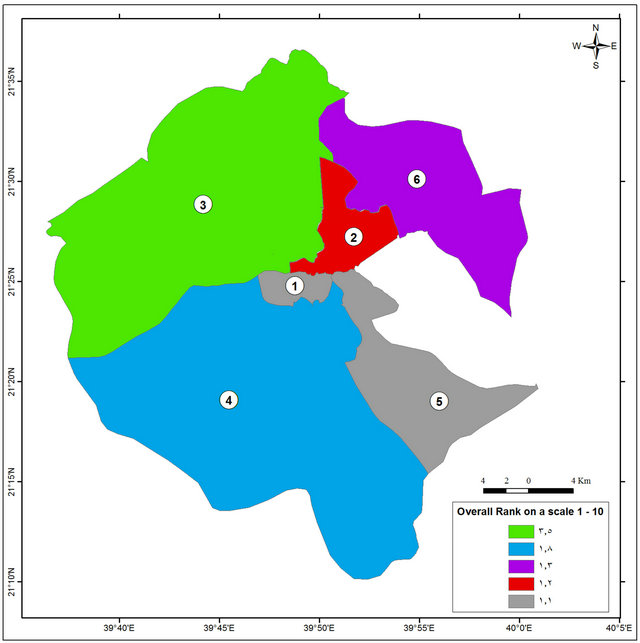
Figure 12. Public services overall index.

Figure 13. Lorenz curves of public services.
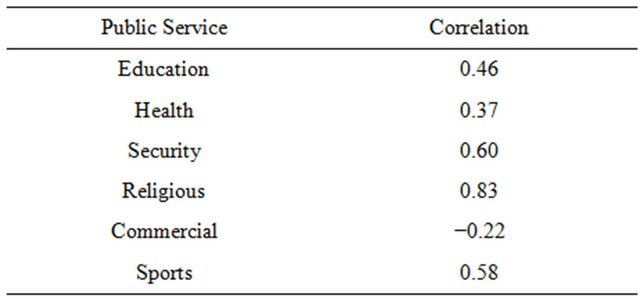
Table 4. Correlation between population and public services quantities.
that the government of KSA and many other Islamic countries are responsible for providing religious services to residents. The inequality in commercial services distribution in Makkah city might be owing to that such private sites are concentrated mainly in the districts that have a large number of hotels, since a large proportion of commercial services depend, to a large extent, on visitors.
The results of the geographically weighted regression, with respect to population, are presented inTable 5. The R2 coefficient of regression represents the goodness of
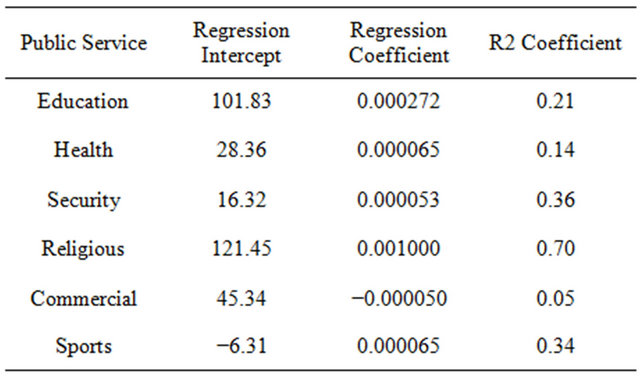
Table 5. Geographically weighted regression between population and public services quantities.
the attained regression equation since it determines the percentage of the variations in the input data that can be modeled by the regression formula. Thus, it can concluded that the attained regression equations are of little goodness for all public services except for religious services only. Again, this is another statistical evidence that there is dissimilarity of public services distribution over the municipal election areas in Makkah city. So, such regression equations could not be appropriate for computing projected numbers of public services in Makkah city. In this regard, another concept has been utilized. First, the number of individuals correspond to a single public service in each election area is computed. The average of these figures, over all municipal election areas, is then obtained. Based on the average population growth rate in KSA (which is 2.9% annually), the population of Makkah city in year 2020 has been computed and was found to be 1,947,330. Next, the average public service/ capita is utilized to estimate total number of each public service type in year 2020. As a conclusion, it has been found that 135, 31, 25, 417, 59, and 74 new services are needed for education, security, health, religious, commercial, and sports services respectively. However, the distribution of these new public services should be on a justice basis regarding population of the municipal election areas in Makkah.
The second group of the accomplished results express the GIS-based spatial analysis of public service distribution. First, the results of the Arc GIS Euclidian-distance tool are shown in Figures 14(a)-(f) for each investigated public service. Additionally, the results of the distanceband-from-neighbor tool are tabulated in Table 6.
Analyzing Table 6 reveals that the sports public services have the maximum mean distance neighbors, while the religious services show the minimum value. Inspecting the figures of Euclidian distance variation between neighbors conclude that the interval 0 - 1000 meters (the yellow interval) is dominant for all public services except for sports services. The inequality of the services spatial distribution, over the municipal election areas, is obviously seen in these figures.
Furthermore, the results of the Arc GIS standard distance, deviational distribution ellipse (both at one standard-deviation level), and nearest neighbor ratio tools are presented in Table 7 and depicted in Figures 15(a)-(f) for each investigated public service. It can be noticed that the standard circles for all public service are centered on the city central area (the holy mosque area), which is quit logical since this area has the highest population and tourists density. The only exception is found in the spatial distribution of the sports services where the centers of both the standard circle and the deviational ellipse have been moved northwest (Figure 15(f)). The attained results of the nearest neighbor ration have been computed using the total area of the urbanized extents of Makkah city, which equals 291.45 square kilometers. That means that these results are realistic rather than using the sum area of the six election regions. The lessthan-one values of the nearest neighbor ratios indicate that the spatial pattern of distribution of all public service is the clustered pattern. That concludes the previouslyachieved remark that the public services in Makkah city are not uniformly distributed in space, due to its topography.
After the text edit has been completed, the paper is ready for the template. Duplicate the template file by

Table 6. Distance to a neighbor for public services.
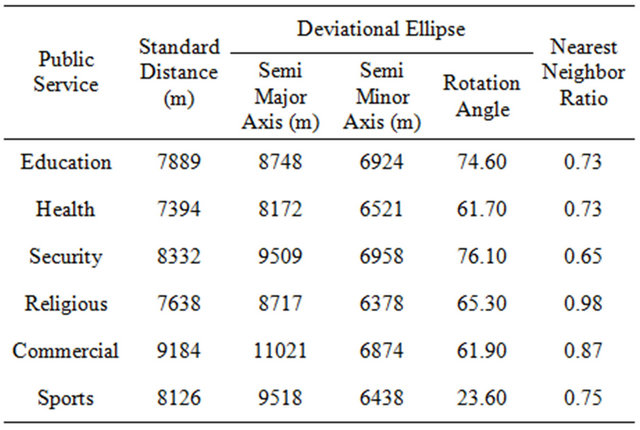
Table 7. Spatial statistics for public services.
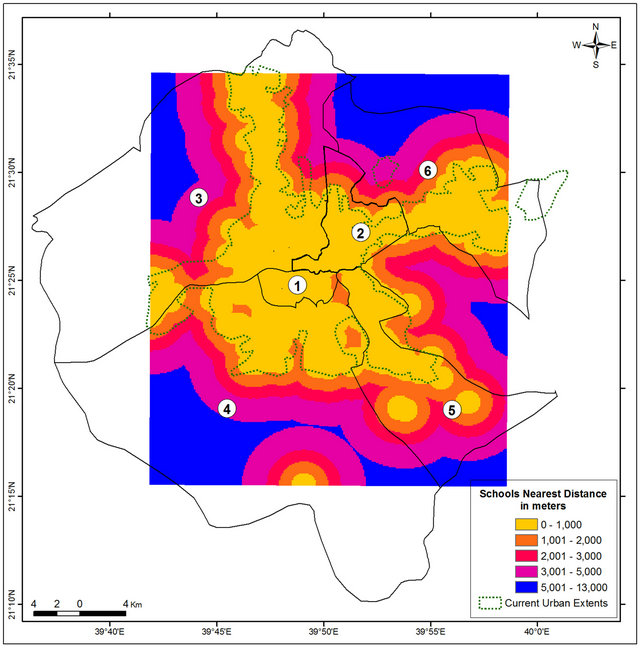 (a)
(a)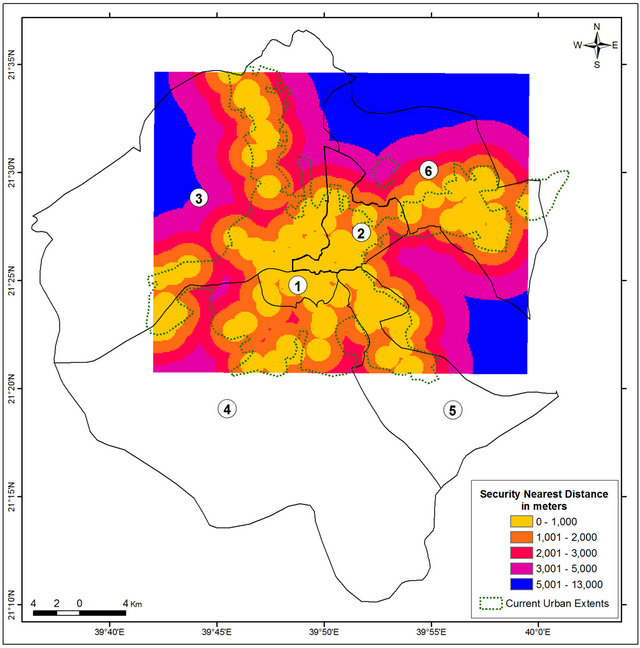 (b)
(b)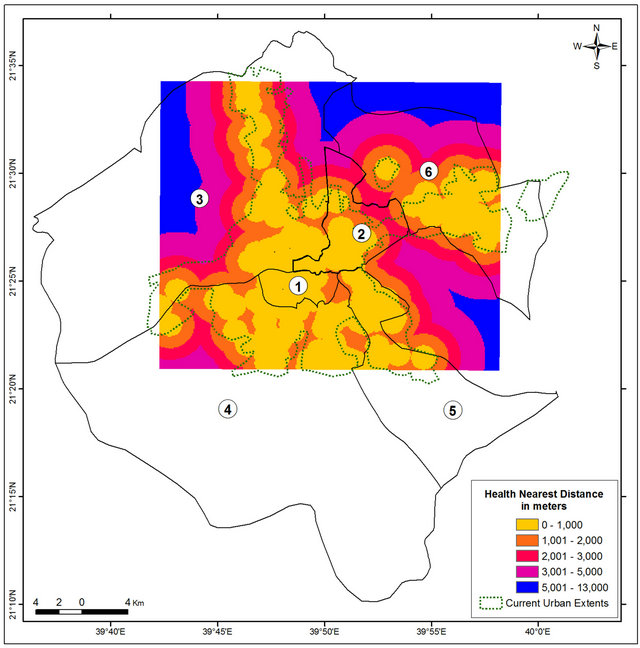 (c)
(c) (d)
(d)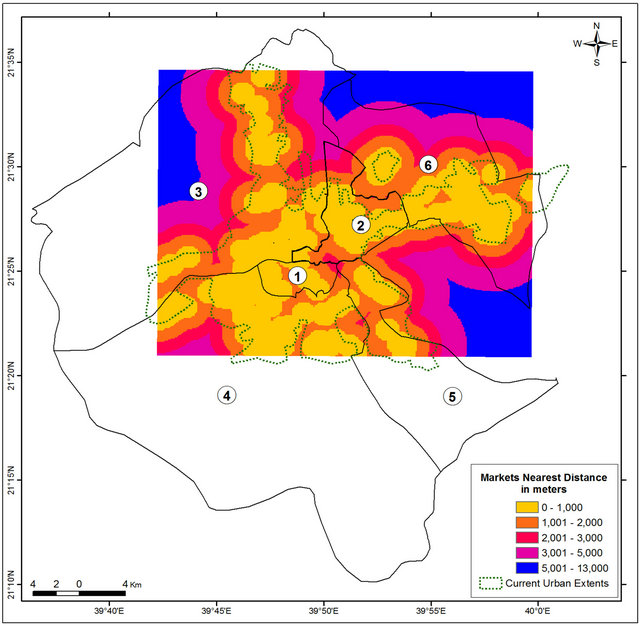 (e)
(e)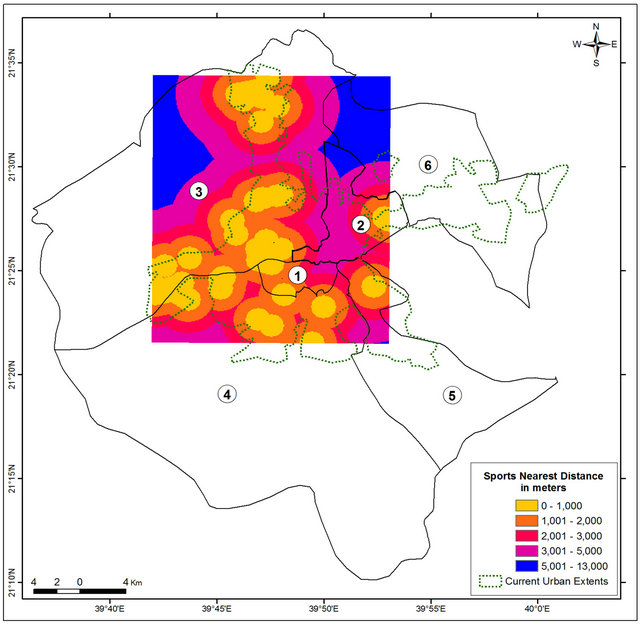 (f)
(f)
Figure 14. Distance variation of public services. (a) Education services; (b) Security services; (c) Health services; (d) Religious services; (e) Commercial services; (f) Sports services.
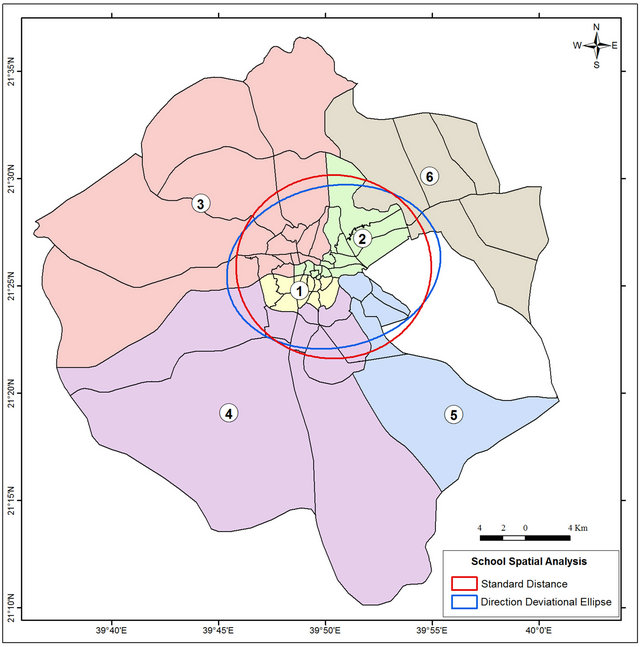 (a)
(a)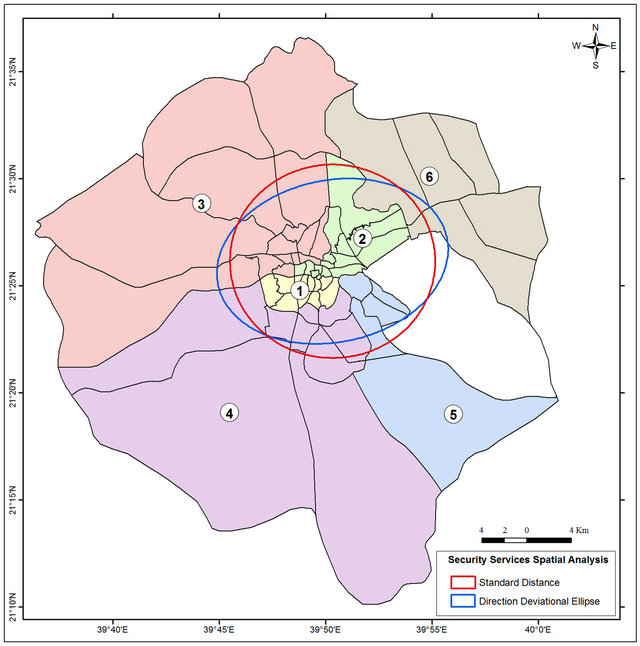 (b)
(b) (c)
(c)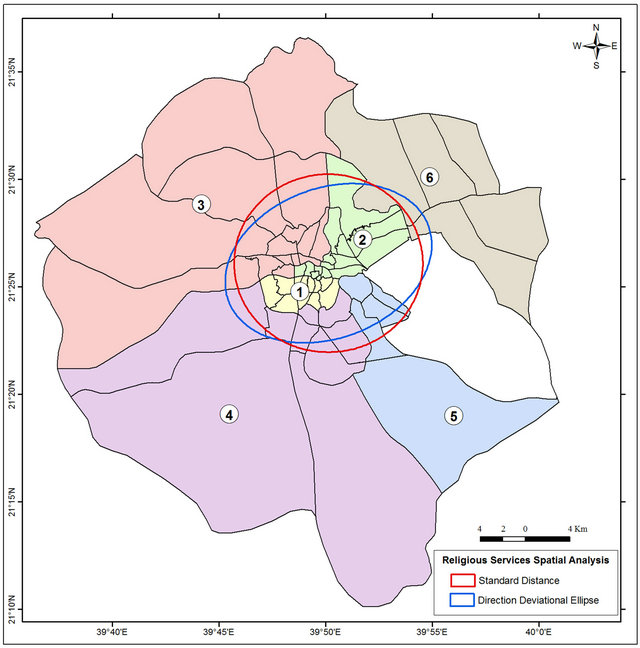 (d)
(d) (e)
(e)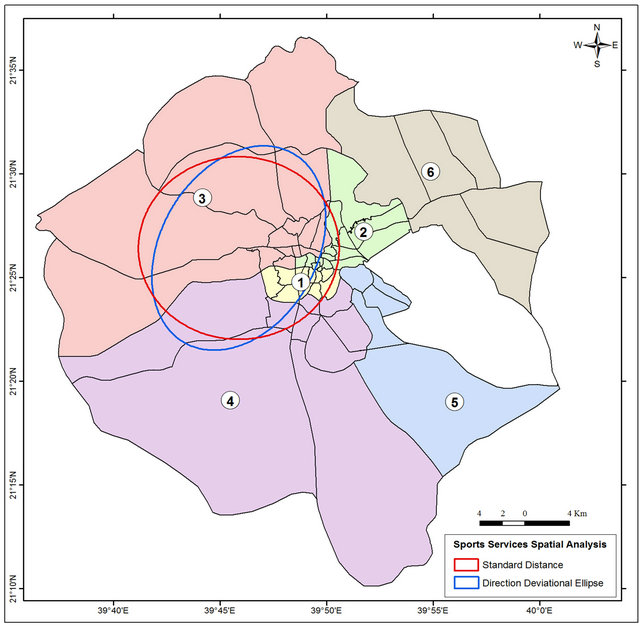 (f)
(f)
Figure 15. Spatial variation of public services. (a) Education services; (b) Security services; (c) Health services; (d) Religious services; (e) Commercial services; (f) Sports services.
using the Save As command, and use the naming convention prescribed by your journal for the name of your paper. In this newly created file, highlight all of the contents and import your prepared text file. You are now ready to style your paper.
6. Conclusion
Gomaa M. Dawod, Meraj N. Mirza, Ramze A. Elzahrany, Khalid A. Al-Ghamdi Improving the availability of public services to residents is a key element of the Saudi government development plans. Makkah city is inhibited by more than a million. It is also considered the most important city for all Muslims; millions of Muslims visit it annually. This paper has applied GIS technology to investigate the statistical and spatial distributions of some selected public services of municipal election areas in Makkah. Several GIS spatial analysis tools, along with statistical tests, have been utilized to precisely depict the current situation of public services variations and to project the needed public services in the year 2020. Several accomplished results emphasis the inequality nature of the current public service distribution over municipal election areas. For example, most public services show weak correlation with population distribution, and the general spatial pattern of the services distribution was found to be clustered. In particular, the sports services show unfairness in their spatial distribution over current the urbanized extents of Makkah. This study presents a methodological approach for analyzing the spatial distribution of public services in a city based on municipal election areas. Consequently, such a new GIS-based approach could stimulate researchers and planners in other Saudi cities. Thus, it is recommended that the accomplished results should be considered, by local decision makers, in the future city planning in order to afford more justice availability of public services.
REFERENCES
[1] C. Carvalho, C. Brito, and J. Cabral, “Towards a Conceptual Model for Assessing the Quality of Public Services,” International Review on Public and Nonprofit Marketing, Vol. 7, No. 1, 2010, pp. 69-86.
[2] R. Elzahrany, “Geographical Distribution of Health Care Services in Makkah Al-Mukarramah Province (in Arabic),” Research Papers in Geography, Saudi Geographical Society, No. 55, 2003, 58 p.
[3] H. Dadashpoor and F. Rostami, “Measurement of Integrated Index of Spatial Justice in the Distribution of Urban Public Services Based on Population Distribution, Accessibility and Efficiency in Yasuj City,” Urban-Regional Studies and Research Journal, Vol. 3, No. 10, 2011, pp. 1-4.
[4] A. Singh and Kaish, “Exploring the Provision and Accessibility to Urban Basic Services in the Slums of a Medium Sized City of India,” Global Advanced Research Journal of Geography and Regional Planning, Vol. 2, No. 2, 2013, pp. 19-28.
[5] K. Al-Ghamdi, M. Mirza, R. Elzahrany and G. Dawod, “GIS Evaluation of Urban Growth and Flood Hazards: A Case Study of Makkah City, Saudi Arabia,” FIG Working Week, Rome, 6-10 May 2012.
[6] G. Dawod, M. Mirza and K. Al-Ghamdi, “GIS-Based Spatial Mapping of Flash Flood Hazards in Makkah City, Saudi Arabia,” Journal of Geographic Information System, Vol. 3, No. 3, 2011, pp. 217-223. doi:10.4236/jgis.2011.33019
[7] R. Elzahrany, “Auto Spatial Correlation of Health Services Distribution in Jeddah City (in Arabic),” Journal of Gulf and Arabian Peninsula Studies, No. 123, 2005, pp. 193-267.
[8] S. Zhou, Y. Cheng, M. Xiao and X. Bao, “Assessing the Location of Public-and-Community Facilities for the Elderly in Beijing, China,” GeoJournal, Vol. 78, No. 3, 2012, pp. 539-551. doi:10.1007/s10708-012-9450-1
[9] S. Mavoa, K. Witten, T. McCreanor and D. O’Sullivan, “GIS Based Destination Accessibility via Public Transit and Walking in Auckland, New Zealand,” Journal of Transport Geography, Vol. 20, No. 1, 2012, pp. 15-22.
[10] C. Case and T. Hawthorne, “Served or Unserved? A Site Suitability Analysis of Social Services in Atlanta, Georgia Using Geographic Information Systems,” Applied Geography, Vol. 38, 2013, pp. 96-106. doi:10.1016/j.apgeog.2012.11.012
[11] T. Neutens, M. Delafontaine, D. Scott and P. De Maeyer, “A GIS-Based Method to Identify Spatiotemporal Gaps in Public Service Delivery,” Applied Geography, Vol. 32, No. 2, 2012, pp. 253-264.
[12] M. Mirza, G. Dawod and K. Al-Ghamdi, “Accuracy and Relevance of Digital Elevation Models for Geomatics Applications: A Case Study of Makkah Municipality, Saudi Arabia,” International Journal of Geomatics and Geosciences, Vol. 1, No. 4, 2011, pp. 803-812.
Full-Text
ليست هناك تعليقات:
إرسال تعليق